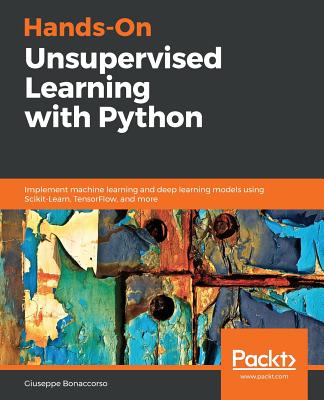Bayesian Analysis with Python: Introduction to statistical modeling and probabilistic programming using PyMC3 and ArviZ, 2/e (Paperback)
暫譯: 使用 Python 進行貝葉斯分析:基於 PyMC3 和 ArviZ 的統計建模與機率程式設計入門,第二版(平裝本)
Osvaldo Martin
- 出版商: Packt Publishing
- 出版日期: 2018-12-26
- 售價: $1,710
- 貴賓價: 9.5 折 $1,625
- 語言: 英文
- 頁數: 356
- 裝訂: Paperback
- ISBN: 1789341655
- ISBN-13: 9781789341652
-
相關分類:
Python、程式語言、機率統計學 Probability-and-statistics
-
相關翻譯:
Python 貝葉斯分析, 2/e (簡中版)
-
其他版本:
Bayesian Analysis with Python - Third Edition: A practical guide to probabilistic modeling
買這商品的人也買了...
-
 機率論 (修訂版)(Ross: A First Course in Probability, 8/e)
機率論 (修訂版)(Ross: A First Course in Probability, 8/e)$780$741 -
 $1,990Spatial Analysis: Statistics, Visualization, and Computational Methods (Hardcover)
$1,990Spatial Analysis: Statistics, Visualization, and Computational Methods (Hardcover) -
 Deep Learning (Hardcover)
Deep Learning (Hardcover)$3,980$3,781 -
 Generalized Principal Component Analysis (Paperback)
Generalized Principal Component Analysis (Paperback)$3,260$3,097 -
 $1,715Introduction to Quantum Mechanics, 3/e (Hardcover)
$1,715Introduction to Quantum Mechanics, 3/e (Hardcover) -
 Data Science with Julia
Data Science with Julia$2,200$2,090 -
 $2,502Hands-On Unsupervised Learning Using Python (Paperback)
$2,502Hands-On Unsupervised Learning Using Python (Paperback) -
 $2,380Practical Time Series Analysis: Prediction with Statistics and Machine Learning (Paperback)
$2,380Practical Time Series Analysis: Prediction with Statistics and Machine Learning (Paperback) -
 $454大話數據分析 — Tableau 數據可視化實戰
$454大話數據分析 — Tableau 數據可視化實戰 -
 Algorithms for Optimization (Hardcover)
Algorithms for Optimization (Hardcover)$1,680$1,646 -
 Computational Bayesian Statistics: An Introduction
Computational Bayesian Statistics: An Introduction$1,800$1,710 -
 $1,788Deep Reinforcement Learning Hands-On, 2/e (Paperback)
$1,788Deep Reinforcement Learning Hands-On, 2/e (Paperback) -
 D3 實用指南|程式設計師和科學家的互動式圖形工具箱 (D3 for the Impatient : Interactive Graphics for Programmers and Scientists)
D3 實用指南|程式設計師和科學家的互動式圖形工具箱 (D3 for the Impatient : Interactive Graphics for Programmers and Scientists)$520$411 -
 Python : 股票演算法交易實務 147個關鍵技巧詳解, 2/e
Python : 股票演算法交易實務 147個關鍵技巧詳解, 2/e$580$452 -
 核心開發者親授!PyTorch 深度學習攻略 (Deep Learning with Pytorch)
核心開發者親授!PyTorch 深度學習攻略 (Deep Learning with Pytorch)$1,000$790 -
 ETF 量化投資學:智能投資的幸福方程式, 2/e
ETF 量化投資學:智能投資的幸福方程式, 2/e$350$315 -
 Interactive Data Processing and 3D Visualization of the Solid Earth (Hardcover)
Interactive Data Processing and 3D Visualization of the Solid Earth (Hardcover)$5,170$4,912 -
 動手學強化學習
動手學強化學習$539$512 -
 $912圖神經網絡:基礎、前沿與應用
$912圖神經網絡:基礎、前沿與應用 -
 $454深度強化學習理論與實踐
$454深度強化學習理論與實踐 -
 擴散模型從原理到實戰
擴散模型從原理到實戰$479$455 -
 Python 大數據專案 X 工程 X 產品 資料工程師的升級攻略, 2/e
Python 大數據專案 X 工程 X 產品 資料工程師的升級攻略, 2/e$780$616 -
 A Pen and Paper Introduction to Statistics (Paperback)
A Pen and Paper Introduction to Statistics (Paperback)$1,710$1,625 -
 Data Visualization in R and Python (Hardcover)
Data Visualization in R and Python (Hardcover)$4,450$4,228 -
 R-Ticulate: A Beginner's Guide to Data Analysis for Natural Scientists (Hardcover)
R-Ticulate: A Beginner's Guide to Data Analysis for Natural Scientists (Hardcover)$3,740$3,553
相關主題
商品描述
An introduction to statistical modeling and probabilistic programming using PyMC3 and ArviZ
Key Features
- A step-by-step guide to conduct Bayesian data analyses using PyMC3 and ArviZ
- A modern, practical and computational approach to Bayesian statistical modeling
- A tutorial for Bayesian analysis and best practices with the help of sample problems and practice exercises.
Book Description
The second edition of Bayesian Analysis with Python is an introductionto the main concepts of applied Bayesian inference and its practicalimplementation in Python using PyMC3, a state-of-the-art probabilisticprogramming library, and ArviZ a new library for exploratory analysis of Bayesian models.
The main concepts of Bayesian statisticsare covered using a practical and computational approach. Synthetic andreal data sets are used to introduce several types of models such asgeneralized linear models for regression and classification, mixturemodels, hierarchical models and Gaussian process among others.
By the end of the book, you will have a working knowledge ofprobabilistic modeling and you will be able to design and implementBayesian models for your own data science problems. After reading thebook you will be better prepared to delve into more advance material orspecialized statistical modeling in case you need it.
What you will learn
- Build probabilistic models using the Python library PyMC3
- Analyze probabilistic models with the help of ArviZ
- Acquire the skills required to sanity check models and modify them if necessary
- Understand the advantages and caveats of hierarchical models
- Find out how different models can be used to answer different data analysis questions
- Compare models and choose between alternative ones
- Discover how different models are unified under a probabilistic perspective
- Think probabilistically and benefit from the flexibility of the Bayesian framework
Who This Book Is For
If you are a student, data scientist, researcher in the natural orsocial sciences, or a developer looking to get started with Bayesiandata analysis and probabilistic programming, this book is for you. Thebook is introductory so no previous statistical knowledge is required,although some experience in using Python and NumPy is expected.
Table of Contents
- Thinking Probabilistically
- Programming Probabilistically
- Modeling with Linear Regression
- Generalizing Linear Models
- Model Comparison
- Mixture Models
- Gaussian Processes
- Inference Engines
- Where to go next?
商品描述(中文翻譯)
使用 PyMC3 和 ArviZ 進行統計建模和概率編程的介紹
主要特點
- 逐步指南,使用 PyMC3 和 ArviZ 進行貝葉斯數據分析
- 現代、實用且計算導向的貝葉斯統計建模方法
- 通過示例問題和練習,提供貝葉斯分析和最佳實踐的教程。
您可以在此 GitHub 倉庫 github.com/aloctavodia/BAP/ 中找到代碼和圖形。您也可以使用此倉庫報告您在書中或代碼中發現的任何問題。
書籍描述
《使用 Python 進行貝葉斯分析(第二版)》是對應用貝葉斯推斷主要概念的介紹,以及如何使用 PyMC3(最先進的概率編程庫)和 ArviZ(用於貝葉斯模型探索性分析的新庫)在 Python 中進行實際實現。
本書使用實用和計算的方法涵蓋貝葉斯統計的主要概念。使用合成和真實數據集來介紹幾種類型的模型,例如用於回歸和分類的廣義線性模型、混合模型、層次模型和高斯過程等。
在本書結束時,您將具備概率建模的工作知識,並能夠為自己的數據科學問題設計和實現貝葉斯模型。閱讀本書後,您將更好地準備深入研究更高級的材料或專門的統計建模(如果需要的話)。
您將學到什麼
- 使用 Python 庫 PyMC3 構建概率模型
- 借助 ArviZ 分析概率模型
- 獲得檢查模型合理性和必要時修改模型的技能
- 理解層次模型的優勢和注意事項
- 了解不同模型如何用於回答不同的數據分析問題
- 比較模型並在替代模型之間做出選擇
- 發現不同模型如何在概率視角下統一
- 以概率思考,並受益於貝葉斯框架的靈活性
本書適合誰閱讀
如果您是學生、數據科學家、自然或社會科學研究人員,或是希望開始進行貝葉斯數據分析和概率編程的開發者,本書適合您。這本書是入門級的,因此不需要先前的統計知識,但預期您對 Python 和 NumPy 有一些使用經驗。
目錄
- 以概率思考
- 以概率編程
- 線性回歸建模
- 廣義線性模型
- 模型比較
- 混合模型
- 高斯過程
- 推斷引擎
- 接下來該去哪裡?












